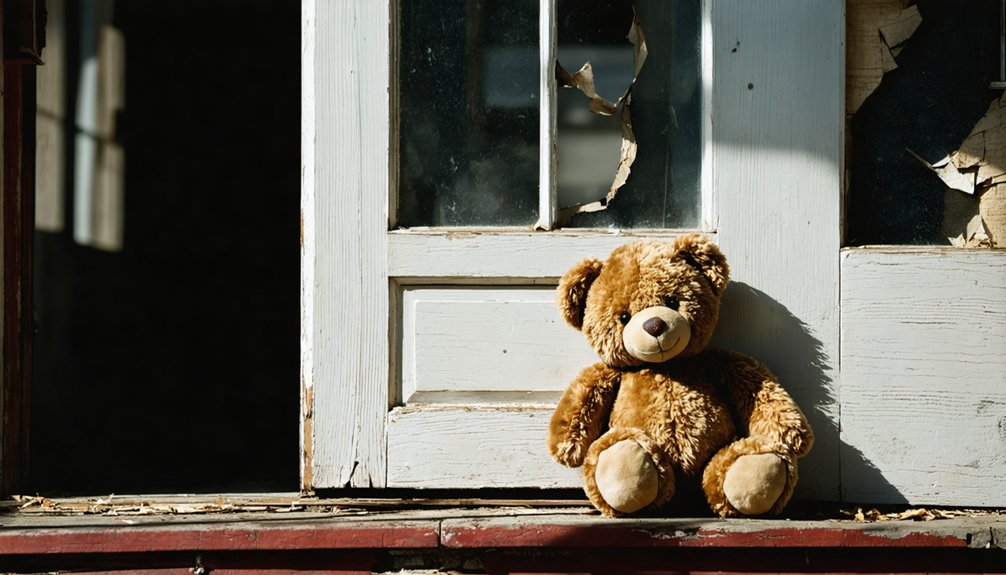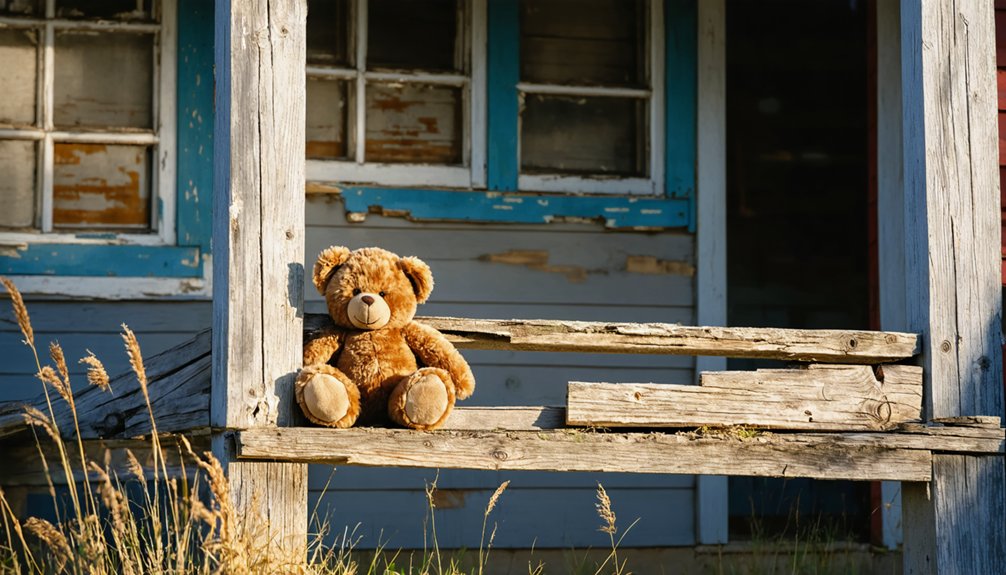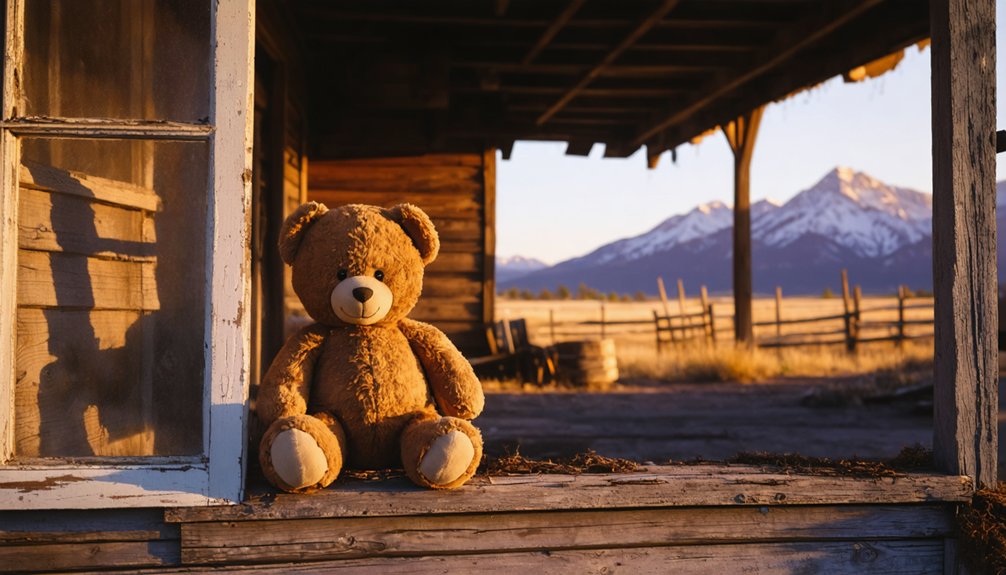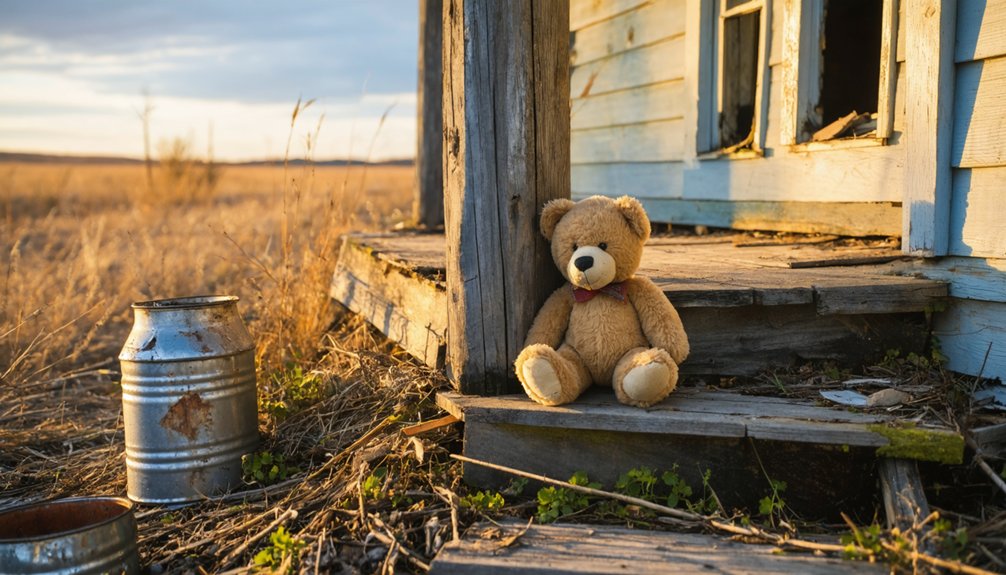You’ll find Teddy Bear Town‘s remnants tucked away in Hill City, South Dakota, where Jackie Miley’s record-breaking collection of over 8,000 teddy bears once drew visitors to a historic 1895 building before its closure in 2018. While the beloved tourist attraction no longer operates, its story intertwines with South Dakota’s rich history of ghost towns, mining settlements, and railroad development. The site’s legacy offers a unique window into the region’s boom-and-bust heritage.
Key Takeaways
- Teddy Bear Town in Hill City, South Dakota, established in 2000, housed over 8,000 teddy bears before closing in 2018.
- The town emerged during the railroad expansion era as a transportation hub but declined by mid-1900s due to route consolidation.
- No preserved historic structures remain, with only rubble and foundation traces marking the former railroad settlement.
- The site currently lacks formal preservation efforts, modern amenities, or organized tourism infrastructure.
- Located in Lawrence County, which contains 93 ghost towns, making it the second-highest concentration of ghost towns in America.
The Truth About Teddy Bear Town in Hill City
While many visitors assume Teddy Bear Town was a long-standing South Dakota institution, this unique attraction actually began in 2000 when Jackie Miley won her first teddy bear on vacation.
You’d be amazed to learn how quickly her collection grew – from zero to over 3,600 bears in just five years, earning her the Guinness World Record in 2005. The bears found a permanent home in Teddy Bear Town, which was housed in a historic building from 1895. By 2017, she’d amassed more than 8,000 bears from every U.S. state and 29 countries.
From one bear to thousands worldwide, Jackie Miley’s collection exploded to over 8,000 plush treasures in less than two decades.
Located on Main Street in Hill City, Teddy Bear Town showcased bears of all sizes, from tiny 5 cm plushies to massive 8-foot giants. Today, visitors can see an even larger collection in Hungary, where Arnóczki’s 20,367 bears set a new world record in 2019.
Miley’s emotional connection to the bears stemmed from never having one as a child. Though the attraction closed in 2018, it remains a symbol of how one person’s passion can create something extraordinary.
Historical Mining Settlements in South Dakota
When you explore South Dakota’s Black Hills region, you’ll find that the 1874 gold discovery sparked an unprecedented rush of prospectors who established numerous mining settlements throughout Lawrence and Pennington counties. Today, many of these sites exist as ghost town remains in various states of deterioration.
You can still see evidence of the era’s mining equipment evolution, from basic gold pans and sluice boxes used in early placer mining to the sophisticated stamp mills and hoisting technology that characterized operations like the Homestake Mine.
These technological advancements helped transform primitive mining camps into established towns, though many would later become ghost towns as mineral deposits were depleted and operations became economically unfeasible. The discovery of less than one ounce of gold per ton at the Homestake Mine demonstrated how even low-grade ore could sustain long-term mining operations when found in abundant quantities.
Black Hills Gold Rush
After Lieutenant Colonel George Armstrong Custer’s 1874 expedition discovered gold near present-day Custer, South Dakota, the Black Hills exploded into one of America’s most controversial gold rushes.
You’ll find the gold rush impact rippled through every aspect of the region, transforming quiet hills into bustling boomtowns like Deadwood and Lead. The San Francisco investors led by George Hearst would turn Homestake into America’s richest gold mine.
The mining town culture that emerged was wild and lawless, packed with saloons, gambling halls, and brothels. While some struck it rich, particularly at the legendary Homestake Mine, most wealth concentrated among corporate investors. The town of Deadwood quickly grew to a population of seven thousand residents by 1876.
You’re looking at a rush that violated the Fort Laramie Treaty with the Sioux, leading to the Great Sioux War and Custer’s Last Stand.
The environmental and social consequences of this era continue to shape the Black Hills, from abandoned mines to ongoing legal disputes over Native American land rights.
Mining Equipment Evolution
Throughout the Black Hills’ early mining days, you’d find miners crushing ore with basic tools like sledgehammers and primitive arastra mills, where animals dragged heavy stones across ore beds.
But as mining technology advancements swept through the region, you’d see a dramatic shift from manual labor to mechanized operations. By 1900, you’d hear the distinctive sound of pneumatic drills echoing through the mines, replacing the slow process of hand drilling. The discovery of gold in French Creek sparked this rapid technological evolution.
Historical equipment adaptations included the introduction of jaw crushers and powerful stamp mills, like the pioneering Jones and Pinney Mill of 1876.
The game-changer came with cyanide processing, letting you extract gold from low-grade ores that were previously worthless. These innovations transformed mining from a crude operation into an efficient, industrialized process.
Impact of Railroad Development on Local Communities
You’ll find that Teddy Bear’s story mirrors countless other South Dakota towns born during the railroad expansion era, when the iron horse first carved paths across the prairie.
Like many railroad-dependent settlements, Teddy Bear sprouted up along the tracks as a crucial transportation hub, bringing workers, commerce, and fleeting prosperity to the area.
The Transcontinental Railroad in the 1870s and 1880s made it possible for more settlers to reach these remote prairie locations with greater ease.
When railroad operations shifted and mechanization took hold, the town’s essential purpose faded, leading to the familiar pattern of declining population and eventual abandonment that you can witness in its quiet remains today.
The name itself shares an unexpected connection to President Theodore Roosevelt, whose famous refusal to shoot a trapped bear during a hunting trip inspired the beloved stuffed toy’s creation.
Railroad Expansion Era
The railroad’s arrival in South Dakota during the late 19th century transformed the region’s economic and social landscape, particularly affecting small communities like Teddy Bear.
As tracks stretched across the prairie, you’d have witnessed a dramatic economic transformation that shifted the balance of power among frontier settlements. Towns lucky enough to secure a railway connection saw immediate benefits – new businesses, grain elevators, and trading posts sprung up practically overnight.
This railroad migration created instant winners and losers. If you’d lived in a town along the rail line, you’d have seen saloons, hotels, and warehouses pop up to serve both locals and travelers.
The rails didn’t just bring goods and people; they brought prosperity, connecting these small prairie communities to larger markets and turning isolated outposts into bustling commercial hubs.
Like Okaton’s establishment in 1906, many towns emerged when the railroad first arrived, bringing rapid development and growth to previously empty landscapes.
Town Growth Near Tracks
When railroad tracks carved through the Dakota Territory in the late 1800s, emerging towns like Teddy Bear quickly organized themselves around these essential transportation arteries.
Like many ghost town origins, you’d find the settlement taking shape as depot buildings, grain elevators, and general stores sprouted up alongside the steel rails. The railroad impact transformed the empty prairie into a bustling community, with new residents drawn by the promise of jobs in construction, maintenance, and railway operations.
You can trace Teddy Bear’s early growth through the familiar pattern of railroad town development – businesses clustered near the tracks for easy access to shipping, while homes and public services spread outward in an organized grid.
The town’s future seemed bright as the railway brought increased trade, new settlers, and economic opportunities.
Transportation Hub Decline
Despite early promise and rapid growth, Teddy Bear’s status as a thriving railroad hub began to waver by the mid-1900s.
Like many South Dakota towns, you’d have witnessed its transportation legacy fade as railroad companies consolidated their routes and shifted operations elsewhere. The economic transformation hit hard – businesses that once thrived on rail traffic struggled to stay afloat, and locals started moving away in search of better opportunities.
You can still see hints of Teddy Bear’s railroad past in its abandoned structures.
As automobiles and highways gained prominence, the town’s isolation grew more pronounced. While some South Dakota communities managed to adapt by developing tourism or specialized services, Teddy Bear couldn’t sustain itself.
The maintenance costs of aging rail infrastructure, coupled with dwindling commerce, ultimately sealed its fate.
Architectural Remnants and Heritage Sites

As decades of neglect took their toll, Teddy Bear’s architectural heritage gradually disappeared, leaving behind little more than scattered rubble and foundation traces typical of abandoned Black Hills mining settlements.
You won’t find any preserved historic structures or maintained heritage sites here – the town’s architectural significance has largely faded into the landscape.
Unlike some of the region’s more documented ghost towns, Teddy Bear lacks formal preservation efforts or historical designations.
Community memory of the site exists mainly through scattered historical records and regional publications, with no organized interpretation or tourism infrastructure.
If you’re exploring the area, you’ll likely encounter only overgrown ruins and possible archaeological remnants, as the site remains undeveloped and largely forgotten by preservation initiatives.
Notable Landmarks and Attractions
The notable landmarks near Teddy Bear ghost town stand in stark contrast to its own scarce remains.
You’ll find yourself surrounded by the majestic Black Hills, where scenic trails wind through the rugged terrain. The area’s ghostly legends come alive as you explore these natural wonders:
- Bear Butte Creek meanders through the nearby Galena district, offering pristine views and hiking opportunities.
- Hill City serves as your gateway to the region, with its visitor center providing essential information about local attractions.
- Pactola Lake conceals the submerged remnants of another ghost town beneath its waters.
- Route 385 connects you to numerous historical sites and abandoned mining camps.
For the most authentic experience, you’ll want to time your visit with Galena’s annual celebration, where you can immerse yourself in the area’s rich mining heritage.
Preservation Challenges and Initiatives

You’ll find Teddy Bear’s preservation efforts hampered by its basement ruins, which present unique structural challenges rarely seen in Black Hills ghost towns.
Local community groups can’t easily protect the site due to complex ownership issues and restricted access to the deteriorating structures at 4,770 feet elevation.
Emergency measures to stabilize the remaining foundations have stalled without formal historic designation or sufficient funding sources, especially after Teddy Bear Town’s closure in 2020 reduced regional interest.
Structural Restoration Projects
Preserving historic structures in Teddy Bear, South Dakota, faces significant challenges due to limited funding and harsh environmental conditions.
Restoration funding often falls short of what’s needed, making community involvement essential for successful preservation efforts.
You’ll find these critical aspects in local restoration projects:
- Local volunteers and preservation groups work together to maintain historic buildings despite limited resources and technical expertise.
- Weather damage from harsh winters and flooding requires constant monitoring and repair of structural elements.
- Private sector partnerships help bridge funding gaps through tourism initiatives and adaptive reuse projects.
- Historical documentation and research guide restoration efforts, ensuring authenticity while meeting modern safety standards.
When you’re involved in these projects, you’ll need to balance preserving original materials with practical solutions for long-term sustainability.
Community Heritage Protection
Beyond structural restoration, safeguarding Teddy Bear’s heritage demands a thorough approach to community protection initiatives.
You’ll find that successful preservation relies heavily on community engagement through local historical societies and educational programs that connect residents with their shared past. By partnering with educational institutions and organizing heritage education workshops, you’re ensuring that preservation skills and knowledge get passed down to future generations.
You can support these efforts by participating in crowdfunding campaigns or volunteering at community events.
Digital technologies now make it easier to document and share Teddy Bear’s history through virtual tours and 3D modeling. Local zoning laws and preservation regulations help protect the site from development, while community-led initiatives create a sense of ownership that’s essential for long-term conservation.
Emergency Stabilization Measures
As weather and vandalism threaten Teddy Bear’s historic structures, emergency stabilization measures have become critical for their survival.
You’ll find these stabilization techniques essential for preserving the town’s remaining buildings:
- Reinforce deteriorating timber frames and secure foundations with concrete underpinning to prevent collapse during South Dakota’s harsh weather.
- Install temporary roof patches and tarps while implementing rapid emergency response protocols for storm damage.
- Set up security cameras, motion detectors, and fencing to protect against vandalism and unauthorized access.
- Remove invasive plants and control vegetation that could undermine foundations or trap moisture against structures.
Regular inspections and documentation through 3D scanning help track the effectiveness of these measures, ensuring Teddy Bear’s architectural heritage remains standing for future generations to explore.
Tourism Opportunities and Local Economy

While many ghost towns in the Black Hills region attract regular tourism, Teddy Bear remains largely untapped as a visitor destination.
You’ll find only authentic log buildings and scattered mining structures here, with no modern tourist amenities or marked trails. Unlike developed sites such as Galena, ghost town tourism at Teddy Bear generates virtually no local economic impact, as there aren’t any nearby businesses or services catering to visitors.
If you’re looking for an unspoiled historical experience, you’ll need to be self-reliant and prepared for remote exploration.
The site’s neglected status and lack of infrastructure mean you won’t encounter organized tours or events. However, this authenticity could appeal to adventurous travelers seeking a genuine ghost town experience away from commercialized attractions.
Life in Early South Dakota Mining Towns
The South Dakota Black Hills erupted with bustling activity after gold discoveries in 1874, transforming untamed wilderness into thriving mining settlements practically overnight.
You’d find yourself amid a diverse mix of prospectors, gamblers, and entrepreneurs, all seeking their fortunes in these rough-and-tumble towns.
- You couldn’t escape the harsh realities of community interactions, where saloons and gambling halls served as the heart of social life.
- Labor struggles defined daily existence, with dangerous underground work and long hours becoming the norm.
- You’d likely live in crowded, modest housing while dealing with limited sanitation and constant fire risks.
- If you were lucky, you’d find support within tight-knit ethnic communities that formed naturally among miners sharing similar backgrounds.
Photography and Exploration Guidelines
Before setting foot in Teddy Bear’s weathered remains, you’ll need to master essential guidelines that protect both you and the site’s historical integrity.
Proper exploration etiquette starts with securing photography permissions and landowner approval to avoid trespassing issues. Pack your wide-angle lens for capturing expansive interior shots, but skip the flash photography that could damage delicate artifacts.
You’ll want to dress for success with sturdy boots and safety gear while carrying emergency communication devices. Stay on marked paths to prevent structural damage, and remember – nothing leaves the site except your photos.
Report any vandalism to local authorities, and time your visits during daylight hours when natural light creates the best shooting conditions.
Understanding South Dakota’s Ghost Town Legacy
Standing among South Dakota’s rolling prairies and weathered hills are hundreds of forgotten settlements that tell a fascinating story of frontier dreams and economic turbulence.
Beyond common ghost town myths, you’ll discover a complex tapestry of settlement patterns that shaped the state’s development.
What makes South Dakota’s ghost towns unique:
- With 245 documented abandoned settlements, SD ranks among the top states for ghost towns nationwide.
- Lawrence County alone contains 93 ghost towns, second only to California’s Kern County.
- Nearly 20% of America’s towns with 10 or fewer residents are found in South Dakota.
- These sites aren’t just mining camps – they’re former railroad hubs, farming communities, and frontier outposts.
You’re walking through living history where boom-and-bust cycles, changing transportation routes, and agricultural shifts transformed thriving communities into silent testimonials of the American frontier.
Frequently Asked Questions
Are There Any Reported Paranormal Activities in Teddy Bear Town?
You won’t find any documented ghost sightings or haunted locations here. Historical records and paranormal databases don’t mention supernatural activity, and there aren’t any local legends about strange occurrences.
What Wildlife Can Visitors Typically Encounter Near Abandoned South Dakota Settlements?
You’ll spot diverse wildlife sightings near abandoned settlements, including mule deer, pronghorn antelope, golden eagles, and coyotes. Thanks to environmental conservation efforts, you might even glimpse endangered black-footed ferrets.
How Did Native American Communities Interact With These Early Mining Towns?
You’ll find that Native Americans largely opposed these mining settlements as violations of sacred lands, with minimal cultural exchange and devastating economic impact on traditional ways of life.
What Were the Most Common Occupations Besides Mining in These Towns?
While farmers tilled distant fields and traders carved routes, you’d find merchants running stores, innkeepers housing travelers, blacksmiths forging tools, and saloonkeepers serving drinks in these bustling towns.
Did Any Famous Outlaws or Historical Figures Frequent These Settlements?
You won’t find solid evidence of outlaw legends or historical visits in this settlement. While the Black Hills drew famous figures, they stuck to larger towns like Deadwood instead.
References
- https://www.youtube.com/watch?v=uCaj6m8TXv4
- https://www.sdhspress.com/journal/south-dakota-history-2-2/some-black-hills-ghost-towns-and-their-origins/vol-02-no-2-some-black-hills-ghost-towns-and-their-origins.pdf
- https://icatchshadows.com/okaton-and-cottonwood-a-photographic-visit-to-two-south-dakota-ghost-towns/
- https://kxrb.com/south-dakota-ghost-towns/
- https://www.blackhillsbadlands.com/blog/post/old-west-legends-mines-ghost-towns-route-reimagined/
- https://www.tripadvisor.com/Attraction_Review-g54645-d3333826-Reviews-Teddy_Bear_Town-Hill_City_South_Dakota.html
- https://en.wikipedia.org/wiki/List_of_ghost_towns_in_South_Dakota
- https://www.lovetowander.co.uk/blog/first-teddy-bear
- https://www.deseret.com/2012/7/31/20427129/south-dakota-woman-holds-record-for-largest-bear-collection/
- https://peluche-kingdom.com/en/blogs/tout-savoir-sur-lunivers-des-peluches/plus-grande-collection-ours-en-peluche-du-monde



